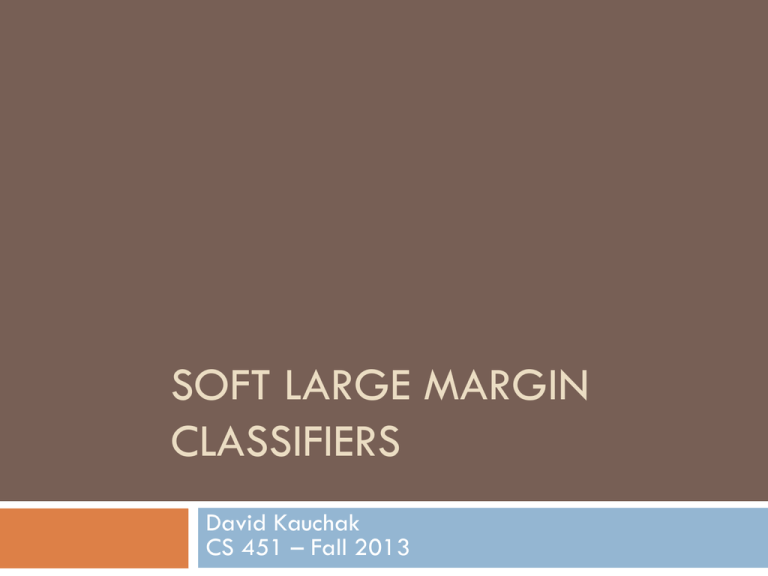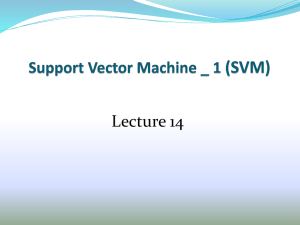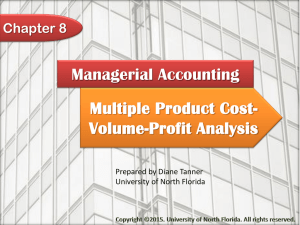lecture17-soft_margin
advertisement

SOFT LARGE MARGIN CLASSIFIERS David Kauchak CS 451 – Fall 2013 Admin Assignment 5 Midterm Friday’s class will be in MBH 632 CS lunch talk Thursday Java tips for the data -Xmx -Xmx2g http://www.youtube.com/watch?v=u0VoFU82GSw Large margin classifiers margin margin The margin of a classifier is the distance to the closest points of either class Large margin classifiers attempt to maximize this Support vector machine problem min w,b w 2 subject to: yi (w× xi + b) ³1 "i This is a a quadratic optimization problem Maximize/minimize a quadratic function Subject to a set of linear constraints Many, many variants of solving this problem (we’ll see one in a bit) Soft Margin Classification min w,b w 2 subject to: yi (w× xi + b) ³1 "i What about this problem? Soft Margin Classification min w,b w 2 subject to: yi (w× xi + b) ³1 "i We’d like to learn something like this, but our constraints won’t allow it Slack variables min w,b w 2 subject to: yi (w× xi + b) ³1 "i min w,b w + Cå V i 2 i subject to: yi (w× xi + b) ³1- V i "i Vi ³ 0 slack variables (one for each example) What effect does this have? Slack variables min w,b w + Cå V i 2 i subject to: yi (w× xi + b) ³1- V i "i Vi ³ 0 slack penalties Slack variables trade-off between margin maximization and penalization margin min w,b w + Cå V i 2 i penalized by how far from “correct” subject to: yi (w× xi + b) ³1- V i "i Vi ³ 0 allowed to make a mistake Soft margin SVM min w,b w + Cå V i 2 i subject to: yi (w× xi + b) ³1- V i "i Vi ³ 0 Still a quadratic optimization problem! Demo http://cs.stanford.edu/people/karpathy/svmjs/demo/ Solving the SVM problem Understanding the Soft Margin SVM min w,b subject to: w + Cå V i 2 i yi (w× xi + b) ³1- V i "i Vi ³ 0 Given the optimal solution, w, b: Can we figure out what the slack penalties are for each point? Understanding the Soft Margin SVM What do the margin lines represent wrt w,b? min w,b subject to: w + Cå V i 2 i yi (w× xi + b) ³1- V i "i Vi ³ 0 Understanding the Soft Margin SVM w× xi + b = -1 w× xi + b =1 min w,b subject to: w + Cå V i 2 i yi (w× xi + b) ³1- V i "i Vi ³ 0 Or: yi (w× xi + b) =1 Understanding the Soft Margin SVM yi (w× xi + b) =1 min w,b subject to: w + Cå V i 2 i yi (w× xi + b) ³1- V i "i Vi ³ 0 What are the slack values for points outside (or on) the margin AND correctly classified? Understanding the Soft Margin SVM yi (w× xi + b) =1 min w,b subject to: w + Cå V i 2 i yi (w× xi + b) ³1- V i "i Vi ³ 0 0! The slack variables have to be greater than or equal to zero and if they’re on or beyond the margin then yi(wxi+b) ≥ 1 already Understanding the Soft Margin SVM yi (w× xi + b) =1 min w,b subject to: w + Cå V i 2 i yi (w× xi + b) ³1- V i "i Vi ³ 0 What are the slack values for points inside the margin AND classified correctly? Understanding the Soft Margin SVM yi (w× xi + b) =1 min w,b subject to: w + Cå V i 2 i yi (w× xi + b) ³1- V i "i Vi ³ 0 Difference from point to the margin. Which is? V i =1- yi (w× xi + b) Understanding the Soft Margin SVM yi (w× xi + b) =1 min w,b subject to: w + Cå V i 2 i yi (w× xi + b) ³1- V i "i Vi ³ 0 What are the slack values for points that are incorrectly classified? Understanding the Soft Margin SVM yi (w× xi + b) =1 min w,b subject to: w + Cå V i 2 i yi (w× xi + b) ³1- V i "i Vi ³ 0 Which is? Understanding the Soft Margin SVM yi (w× xi + b) =1 min w,b subject to: w + Cå V i 2 i yi (w× xi + b) ³1- V i "i Vi ³ 0 “distance” to the hyperplane plus the “distance” to the margin ? Understanding the Soft Margin SVM yi (w× xi + b) =1 min w,b subject to: w + Cå V i 2 i yi (w× xi + b) ³1- V i "i Vi ³ 0 “distance” to the hyperplane plus the “distance” to the margin -yi (w× xi + b) Why -? Understanding the Soft Margin SVM yi (w× xi + b) =1 min w,b subject to: w + Cå V i 2 i yi (w× xi + b) ³1- V i "i Vi ³ 0 “distance” to the hyperplane plus the “distance” to the margin -yi (w× xi + b) ? Understanding the Soft Margin SVM yi (w× xi + b) =1 min w,b subject to: w + Cå V i 2 i yi (w× xi + b) ³1- V i "i Vi ³ 0 “distance” to the hyperplane plus the “distance” to the margin -yi (w× xi + b) 1 Understanding the Soft Margin SVM yi (w× xi + b) =1 min w,b subject to: w + Cå V i 2 i yi (w× xi + b) ³1- V i "i Vi ³ 0 “distance” to the hyperplane plus the “distance” to the margin V i =1- yi (w× xi + b) Understanding the Soft Margin SVM min w,b subject to: w + Cå V i 2 i yi (w× xi + b) ³1- V i "i Vi ³ 0 ìï 0 if yi (w × xi + b) ³1 Vi = í otherwise ïî 1- yi (w × xi + b) Understanding the Soft Margin SVM ìï 0 if yi (w × xi + b) ³1 Vi = í otherwise ïî 1- yi (w × xi + b) V i = max(0,1- yi (w× xi + b)) = max(0,1- yy') Does this look familiar? Hinge loss! 0/1 loss: Hinge: Exponential: Squared loss: l(y, y') =1[ yy' £ 0] l(y, y') = max(0,1- yy') l(y, y') = exp(-yy') l(y, y') = (y - y')2 Understanding the Soft Margin SVM min w,b subject to: w + Cå V i 2 i yi (w× xi + b) ³1- V i "i Vi ³ 0 V i = max(0,1- yi (w× xi + b)) Do we need the constraints still? Understanding the Soft Margin SVM min w,b subject to: w + Cå V i 2 i V i = max(0,1- yi (w× xi + b)) yi (w× xi + b) ³1- V i "i Vi ³ 0 min w,b w + Cå max(0,1- yi (w × xi + b)) 2 i Unconstrained problem! Understanding the Soft Margin SVM min w,b w + Cå losshinge (yi , yi ') 2 i Does this look like something we’ve seen before? n argmin w,b åloss(yy') + l regularizer(w, b) i=1 Gradient descent problem! Soft margin SVM as gradient descent min w,b multiply through by 1/C and rearrange let λ=1/C min w,b min w,b w + Cå losshinge (yi , yi ') 2 i 1 åi losshinge (yi, yi ') + C w å loss i hinge 2 (yi , yi ') + l w 2 What type of gradient descent problem? n argmin w,b åloss(yy') + l regularizer(w, b) i=1 Soft margin SVM as gradient descent One way to solve the soft margin SVM problem is using gradient descent min w,b hinge loss å loss i hinge (yi , yi ') + l w 2 L2 regularization Gradient descent SVM solver pick a starting point (w) repeat until loss doesn’t decrease in all dimensions: pick a dimension move a small amount in that dimension towards decreasing loss (using the derivative) d wi = wi - h (loss(w) + regularizer(w, b)) dwi n w j = w j + hå yi xi1[yi (w × x + b) <1] - hl w j i=1 hinge loss L2 regularization Finds the largest margin hyperplane while allowing for a soft margin Support vector machines One of the most successful (if not the most successful) classification approach: decision tree Support vector machine k nearest neighbor perceptron algorithm Trends over time









